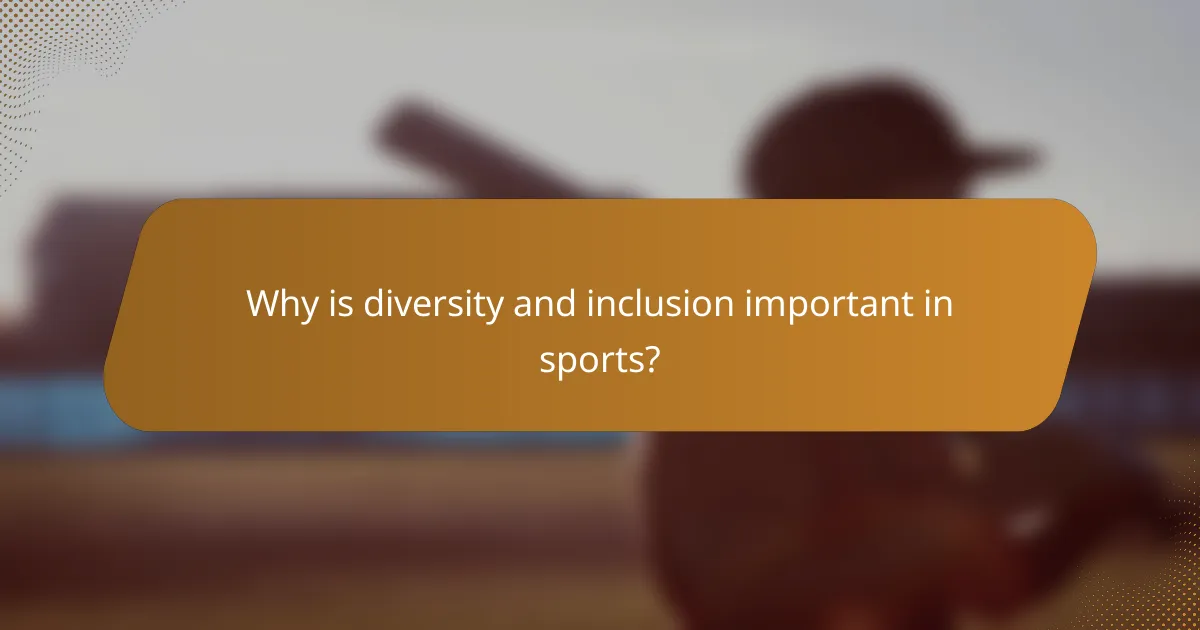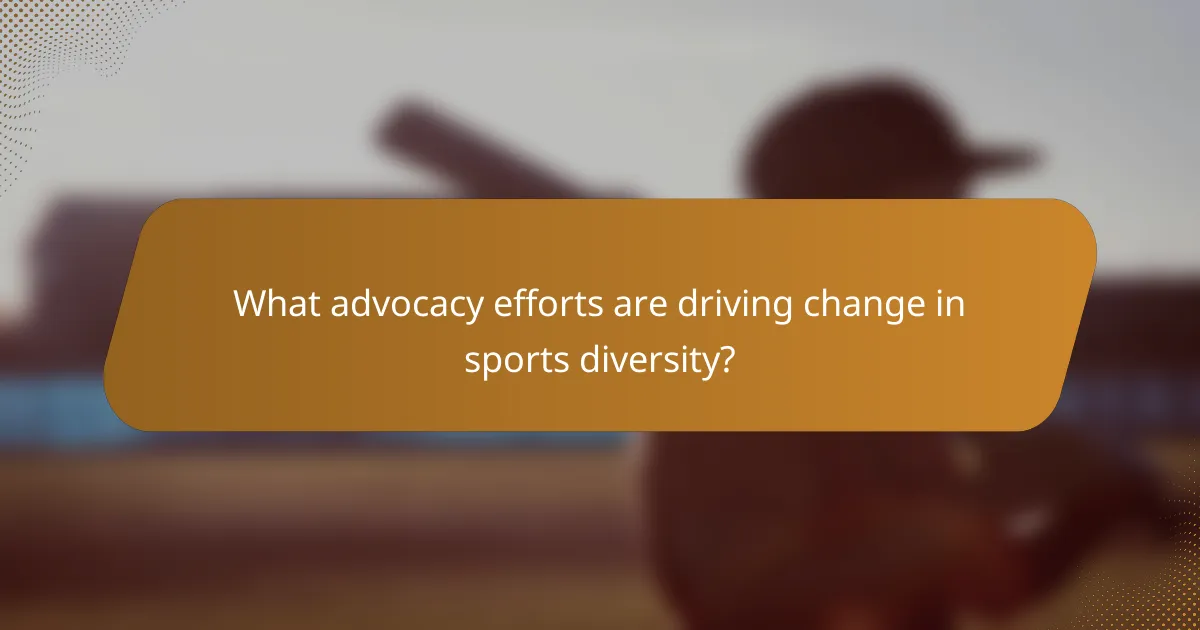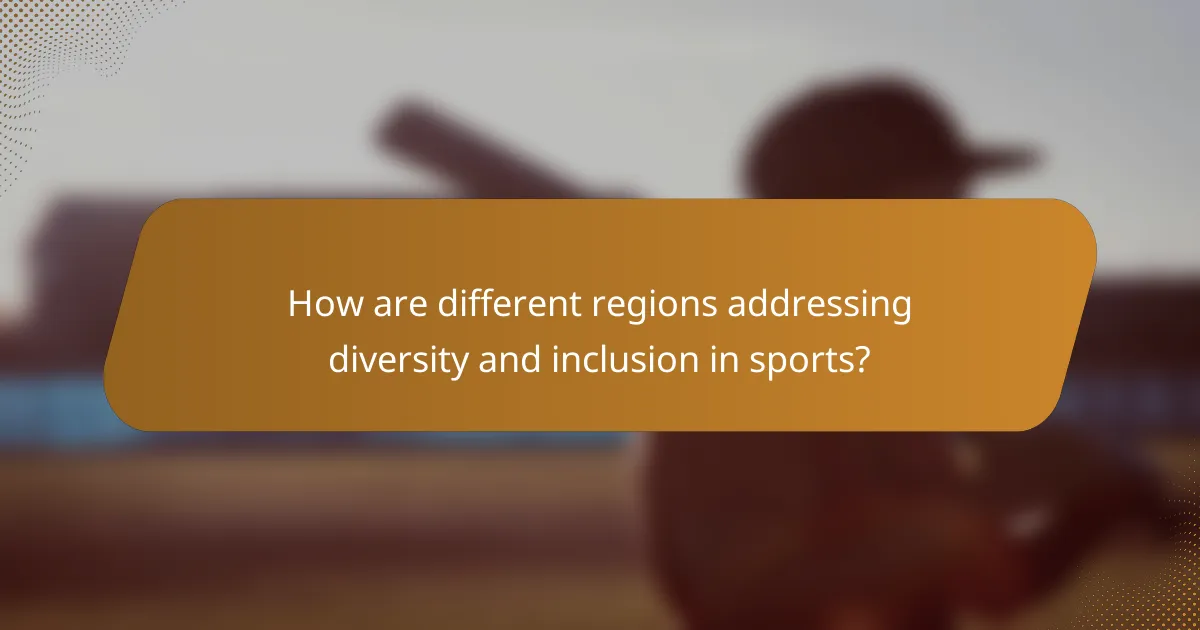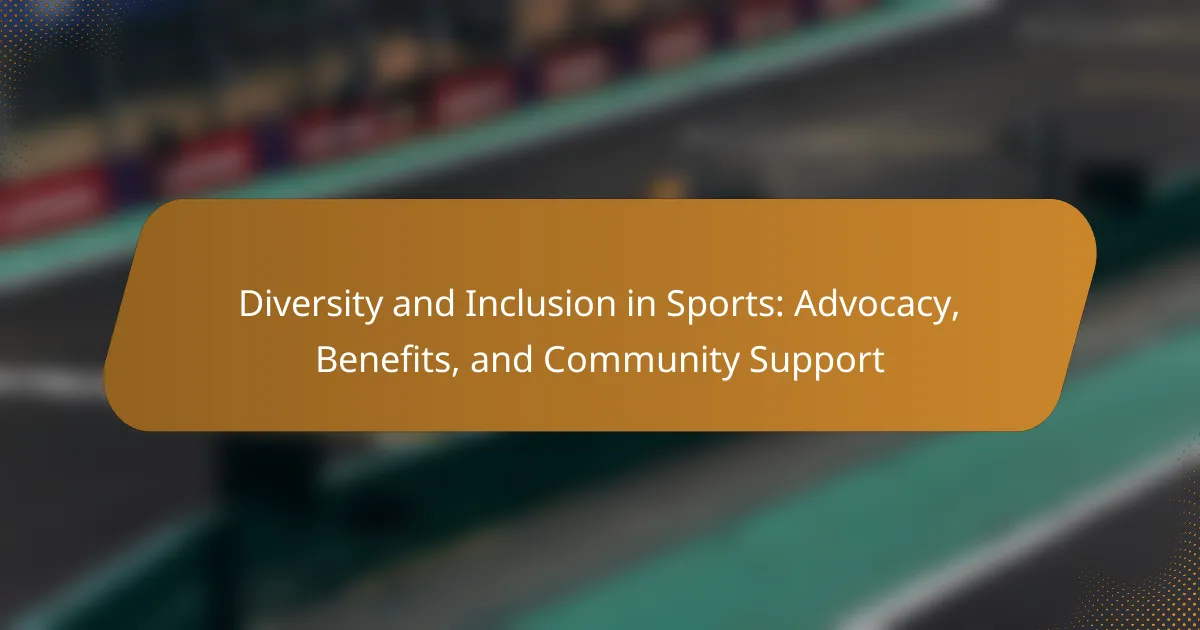Diversity and inclusion in sports enhance team performance and foster community support. Current challenges include systemic barriers and lack of representation. Advocacy efforts focus on inclusion policies and community engagement. Regional strategies vary, with grassroots movements in North America and legislative frameworks in Europe driving change. Measurable impacts highlight the benefits of diverse teams, improving performance and community relations.

Why is diversity and inclusion important in sports?
Diversity and inclusion in sports are crucial for fostering equality, enhancing team performance, and building a supportive community. These principles create an environment where all athletes can thrive, leading to greater innovation and varied perspectives. Inclusivity promotes social cohesion, encouraging participation from diverse backgrounds and helping to break down stereotypes. As a result, sports can reflect and celebrate the richness of society, inspiring future generations.
What are the key benefits of diversity in athletic participation?
Diversity in athletic participation enhances creativity, promotes teamwork, and fosters a sense of belonging. It leads to improved performance through varied perspectives and experiences. Diverse teams often exhibit greater resilience and adaptability, crucial for overcoming challenges. Additionally, inclusive sports environments can drive community engagement and social cohesion, uniting individuals from different backgrounds.
How does inclusion impact team dynamics and performance?
Inclusion positively impacts team dynamics and performance by fostering collaboration and enhancing creativity. Diverse perspectives lead to innovative solutions, improving overall team effectiveness. Research indicates that inclusive teams outperform their peers, demonstrating higher levels of engagement and satisfaction. This synergy promotes a strong sense of community and support, essential for achieving shared goals in sports.

What are the current challenges to achieving diversity in sports?
Current challenges to achieving diversity in sports include systemic barriers, lack of representation, and insufficient funding for minority programs. These factors hinder equitable access and participation across various demographics. For instance, minority athletes often face obstacles in recruitment and advancement due to entrenched biases. Additionally, organizations struggle to implement effective diversity initiatives without adequate resources. As a result, achieving true inclusivity remains a complex issue requiring sustained advocacy and community support.
Which barriers do underrepresented groups face in sports?
Underrepresented groups face barriers such as systemic discrimination, limited access to resources, and lack of representation in leadership roles. These challenges hinder participation and advancement in sports. Additionally, societal stereotypes and biases create an unwelcoming environment. Community support and advocacy are essential to overcoming these obstacles and promoting diversity in sports.
How do cultural perceptions influence participation rates?
Cultural perceptions significantly influence participation rates in sports by shaping attitudes and beliefs about inclusivity. Factors such as societal norms, stereotypes, and historical context dictate who feels welcome in various sports environments. For instance, communities with strong advocacy for diversity often see higher engagement levels among underrepresented groups. Additionally, cultural significance attributed to certain sports can either encourage or deter participation. As a result, fostering a culture of inclusivity can enhance overall participation rates, benefiting the community as a whole.

What advocacy efforts are driving change in sports diversity?
Advocacy efforts driving change in sports diversity focus on inclusion policies, community engagement, and education initiatives. Organizations like the Women’s Sports Foundation promote gender equity, while programs targeting underrepresented groups foster participation. Collaborations with athletes amplify these messages, creating role models. Research shows diverse teams enhance performance and innovation, making advocacy essential for the future of sports.
Which organizations are leading diversity initiatives in athletics?
Several organizations lead diversity initiatives in athletics, including the NCAA, the Women’s Sports Foundation, and the Positive Coaching Alliance. These entities focus on promoting inclusive practices, enhancing representation, and fostering community support within sports. The NCAA has established programs aimed at increasing minority participation in collegiate sports, while the Women’s Sports Foundation advocates for gender equity. The Positive Coaching Alliance emphasizes creating a positive culture in youth sports, which supports diverse participation.
How can athletes and coaches advocate for inclusion?
Athletes and coaches can advocate for inclusion by promoting diverse representation and fostering an inclusive environment. They should engage in open dialogues, educate themselves and their teams about diversity issues, and support initiatives that promote equality in sports. Collaborating with organizations focused on inclusion can amplify their efforts. Additionally, sharing personal experiences can inspire others to join the cause.

What role do community programs play in promoting diversity?
Community programs significantly enhance diversity by fostering inclusion across various demographics. They provide a platform for underrepresented groups to engage in sports, promoting equity and representation. These initiatives often focus on education, outreach, and support, creating a welcoming environment for all participants. As a result, community programs can improve social cohesion and break down barriers, enabling diverse athletes to thrive.
How can local organizations support diverse athletes?
Local organizations can support diverse athletes by creating inclusive programs and fostering community engagement. They should provide resources such as training, mentorship, and access to facilities that cater to varied needs. Collaboration with local schools and community groups can enhance outreach and participation. Additionally, promoting awareness through events and workshops can help address biases and celebrate diversity in sports. Engaging diverse voices in decision-making processes ensures representation and empowers athletes from various backgrounds.
Which successful community initiatives have emerged in recent years?
Several successful community initiatives focused on diversity and inclusion in sports have emerged recently. Programs like “Play Unified” promote inclusion for athletes with and without intellectual disabilities. “Women in Sports” initiatives aim to elevate female representation in leadership roles. Local sports leagues are adopting inclusive practices to welcome diverse participants. Additionally, organizations are creating mentorship programs for underrepresented youth in sports. These efforts enhance community support and foster a more inclusive sports culture.

How are different regions addressing diversity and inclusion in sports?
Different regions are adopting varied strategies to enhance diversity and inclusion in sports. These initiatives include policy reforms, community engagement, and targeted programs to support underrepresented groups.
North America emphasizes grassroots movements and organizational policies promoting equity. For instance, the NCAA has implemented diversity hiring practices to ensure representation in coaching and administrative roles.
Europe focuses on legislative frameworks that mandate inclusion in sports. Countries like Norway have established funding for projects that promote diversity among athletes and coaches.
In Asia, initiatives often center around cultural integration and awareness campaigns. Japan’s sports organizations are increasingly incorporating programs that celebrate diversity, especially in preparation for international events.
Australia showcases community-driven approaches that foster inclusion through local clubs and partnerships. Programs aimed at Indigenous communities highlight the importance of cultural identity in sports participation.
What unique approaches are observed in North America?
North America employs unique approaches to diversity and inclusion in sports through community engagement, policy advocacy, and educational initiatives. Organizations actively promote representation, ensuring underrepresented groups have access to sports programs. For example, initiatives focus on youth mentorship and scholarships, enhancing participation rates among marginalized communities. These strategies foster a sense of belonging and improve overall mental health. Additionally, partnerships with local businesses amplify outreach efforts, creating inclusive environments that celebrate diverse cultures within sports.
How does the UK tackle inclusion in sports settings?
The UK addresses inclusion in sports through policies, programs, and community initiatives. Advocacy groups work to promote diversity, ensuring access for underrepresented populations. Initiatives like “This Girl Can” empower women and girls, increasing participation in sports. Community support fosters inclusive environments, enhancing social cohesion and well-being.

What are the measurable impacts of diversity initiatives in sports?
Diversity initiatives in sports lead to measurable impacts such as enhanced team performance, increased fan engagement, and improved community relations. Studies show diverse teams often outperform homogeneous ones, fostering innovation and creativity. For example, organizations with inclusive practices see a 30% increase in employee satisfaction, translating to better on-field performance. Additionally, diverse representation in leadership roles enhances brand loyalty among diverse fan bases, driving revenue growth. Overall, these initiatives create a more equitable environment that benefits athletes, organizations, and communities alike.
Which metrics are used to assess diversity outcomes in athletics?
Metrics used to assess diversity outcomes in athletics include participation rates, representation in leadership roles, and retention rates. These metrics help evaluate the effectiveness of diversity initiatives in sports organizations.
| Metric | Description | Value Example |
|—————————-|—————————————————|———————–|
| Participation Rates | Percentage of diverse athletes in programs | 40% female athletes |
| Leadership Representation | Diversity in coaching and administrative roles | 25% minority coaches |
| Retention Rates | Longevity of diverse athletes in programs | 75% retention after 3 years |
| Community Engagement | Involvement of diverse communities in events | 60% local outreach |
| Satisfaction Surveys | Feedback from athletes on inclusivity | 80% positive feedback |
| Funding Allocation | Financial support for diversity programs | $500,000 annually |
How can success stories inspire further diversity efforts?
Success stories can significantly motivate further diversity efforts by showcasing tangible benefits and successful outcomes. These narratives highlight how diverse teams enhance performance and creativity, inspiring organizations to adopt inclusive practices. For example, sports teams that embrace diversity often see improved teamwork and community engagement. This ripple effect encourages other organizations to follow suit, fostering an environment where diversity is valued and promoted. Ultimately, success stories serve as powerful testimonials, demonstrating that diversity leads to greater achievements in sports and beyond.
What best practices can organizations adopt for effective diversity strategies?
Organizations can adopt inclusive recruitment, training programs, and community engagement for effective diversity strategies. Prioritizing diverse hiring practices ensures varied perspectives. Implementing training fosters understanding and respect among team members. Engaging with community organizations strengthens support networks and promotes shared values. These practices enhance overall team performance and innovation.
